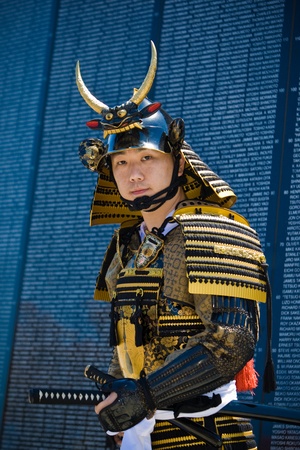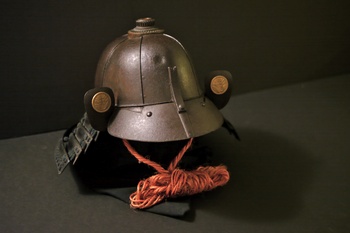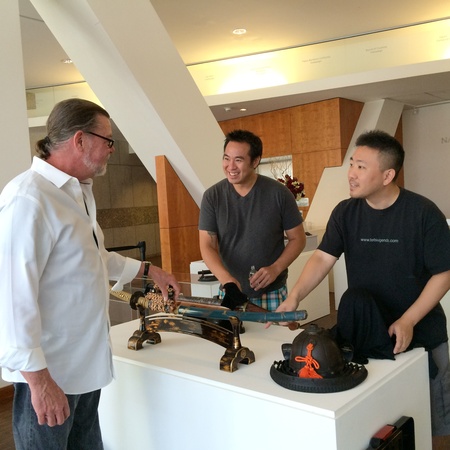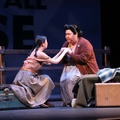Darin S. Furukawa and Mike Yamasaki are co-curators Japanese American National Museum’s new exhibit for the month of August, Jidai: Timeless Works of Samurai Art. Together, they are preserving and passing along an appreciation for traditional Japanese culture.
Responding to emailed questions, Darin shared his perspectives on the exhibit.
1) How did you gain expertise in Japanese swords? A brief bio, please.
I am actually more familiar with samurai armor than swords, but I consider myself still very much a student of both. I graduated from Stanford University with a degree in Art History, with a significant amount of my coursework focusing on the art of Japan. Over the past eight years, I have been working with the artists of Marutake Sangyo, the preeminent armor makers in Japan (their armors have been used in Akira Kurosawa films, NHK Taiga Dramas, and can be found in temples, shrines, dojos, restaurants, and private collections around the world). I was lucky enough to meet Mike Yamasaki through one of my exhibitions at Nisei Week five years ago, and we found we had similar thoughts on the importance of sharing the Japanese culture with the greater community. He has since been generous with his time and knowledge about the Japanese sword. I feel that if he is willing to share what he has learned through his decades of experience, it is my obligation to try to learn as much as I can to continue to protect and preserve these valuable cultural artifacts.
2) How did you become involved in Jidai: Timeless Works of Samurai Art? What is your role?
As alluded to above, the Jidai exhibit is really an evolution of the work Mike and I have done both individually and together in the past. I know that for a number of years, Mike displayed swords with the Nanka Token Kai (LA Sword Club) at Nisei Week. In 2008, I began bringing my armor to the Festival, but the Sword Club had unfortunately ended their participation in the event by that time. In 2010, Mike happened to visit my humble display, and after talking, we thought it would be a great idea to go forward with joint exhibitions featuring my armor and swords and fittings provided by Mike and his business partner, Cyrus Chan. We have exhibited together in every Nisei Week since.
This past year, we were asked by LACMA to curate an exhibit of swords, fittings, and related samurai weaponry that would complement the touring Barbier-Mueller armor collection that they were hosting. Our friend, Terry Hara, who is this year’s Nisei Week President, saw our exhibition and thought it would be great to do something special for this, the 75th Anniversary of the Festival. We were put in contact with the Japanese American National Museum, and they were gracious enough to offer us a space to put up some incredible artifacts that give a glimpse into the world of the samurai, while looking at the importance of these objects to the JA and greater American community.
As for my role, as stated before, I consider myself a mere student of the samurai arts. The fact that I am still learning helps me shape the exhibition by asking the questions that I, as a beginner, am curious about. It is also my role to present the information in a way that the general public can understand and hopefully take something away from.
3) Are people of all nationalities interested in Japanese swords? Do you think younger Japanese Americans, generations removed from Japan, are losing interest in their history and heritage?
The Japanese sword is truly iconic, and its beauty is appreciated the world over. We know collectors of all nationalities, not only here in America, but around the globe.
As for JAs today, I don’t think that they are losing interest in their history. Rather, I think that they simply lack the access to the opportunities to learn, be it from the geographic dispersion of the JA community, or from the passing of those members of the community that were masters of their respective cultural arts. Being a 4th generation Japanese American, myself, I know that I was always excited when I saw a class, event, or even a TV show on Japan (which was usually a rare occurrence). That is why we take every chance we can to put on exhibitions such as this one—hopefully, the 4th, 5th, and 6th (and beyond) generation youth will understand that their history did not start when their ancestors hit these shores. Hopefully, they will see that Japanese history is their history, and be inspired to seek out more opportunities to learn more about their cultural heritage.
4) What do you hope is the exhibit’s take away for visitors?
I know that many will be surprised by just how strikingly beautiful some of these works are. We are making the point that the swords, fittings, and armor were more than just weapons of war. But I really hope that our guests will look at the dates on some of the pieces (some are over twice as old as America), look at their condition, then reflect on how it took the respect, care, and maintenance of generations upon generations of custodians for them to be here today. Of course, I also hope that people leave Jidai with the desire to see and study (and possibly even collect!) the art of the samurai, themselves.
* * * * *
View Jidai: Timeless Works of Samurai Art at the Japanese American National Museum from August 1 to 30, 2015.
© 2015 Esther Newman








